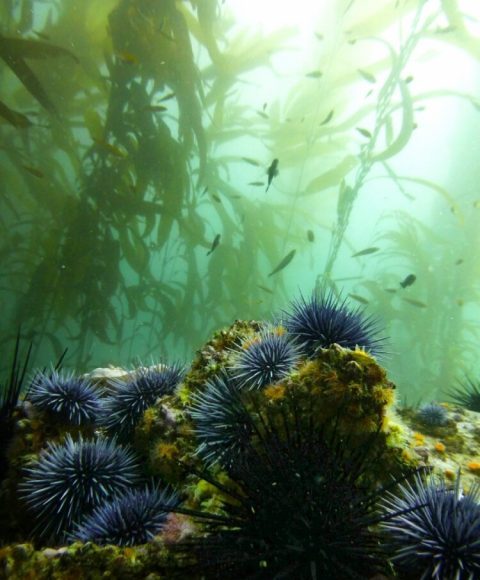Sea urchins receive a lot of attention in California. Red urchins support a thriving fishery, while their purple cousins are often blamed for mowing down kelp forests to create urchin barrens. Yet for all the notice we pay them, we know surprisingly little about the microbiomes that support these spiny species.
Researchers at UC Santa Barbara led by geneticist Paige Miller sought to uncover the diversity within the guts of these important kelp forest inhabitants. Their results reveal significant differences between the microbiota of the two species, as well as between individuals living in different habitats. The study, which appears in Limnology and Oceanography Letters, represents the first step in understanding the function of urchins’ microbial communities, including the possibility that urchins may be able to ‘farm’ microbes in their guts to create their own food sources.
California hosts two common species of sea urchin: red and purple. They generally consume algae, but are actually fairly opportunistic omnivores that will eat decaying plant and animal matter, microbial mats and even other urchins if need be. The microbiome in their guts might help urchins handle such a varied diet, but it hasn’t been examined until now.
“It’s very important to understand what animals eat and why,” Miller said, “and we think the microbiome could play an important role in why species thrive despite all the variation in food availability that’s out there in the ocean.” However, scientists are only beginning to investigate the microbiota of ocean animals, let alone the function these microorganisms serve in their hosts.
To begin their investigation, Miller and her team collected red and purple urchins from three habitats in the Santa Barbara Channel. Some came from lush kelp forests; others from urchin barrens; and a few came from one of the channel’s many hydrocarbon seeps, where they scratch a living feeding on mats of microbes that thrive off of petroleum compounds.
Find your dream job in the space industry. Check our Space Job Board »
Key to this study’s success was the researchers’ stringent protocol. They used meticulous techniques to remove each specimen’s stomach and guts in order to avoid contamination from microbes in the lab, elsewhere on the animal, and even in the sea water.
The researchers were then able to sequence a particular region of the genetic code that scientists commonly use to identify microbes. This enabled them to compare what they found with several comprehensive taxonomic databases that scientists use for genetic identification of microbial life.
The team found significant differences between the bacterial communities living within the two urchin species. However, they saw just as much variation between the microbiomes of individuals from the same species living in different habitats.
“Our study is the first to examine the microbiome in these extremely common, and really ecologically important, species,” said coauthor Robert (Bob) Miller, a researcher at the university’s Marine Science Institute. “We’re just scratching the surface here, but our study shows how complex these communities are.”
One group of bacteria that was prevalent in both species is the same group that helps break down wood in the guts of termites, and could help the urchins digest algae. Previous research indicates that these microbes could potentially be autotrophic. “Some members of this group can create their own food, like photosynthetic plants, for example,” explained Paige Miller, “only they don’t use sunlight for energy, they use hydrogen.”
Although the authors caution against jumping to conclusions, ascertaining whether urchins can produce their own food would be a huge revelation. “We know that the urchins can survive a long time without food,” Bob Miller said. “And they can survive almost indefinitely in these barren areas that have very low food supplies. So, this could really help them out, if they have their own little farmed food supply in their gut.”
The findings also stress the oversight of conflating these similar species. People often treat species like the red and purple sea urchins as equivalent when making decisions about resource use and management, Paige Miller explained. Even ecologists can fall into this line of reasoning. “But it’s very important to look at how these things actually function,” she noted. “And as we saw, the red and purple sea urchins are not necessarily functioning the same way, or eating the same things, if their microbiome is an indicator.”
Understanding the makeup and function of microbiota could help researchers recognize the subtle differences between superficially similar species. “More recently, people have begun considering the microbiome as another trait that these species have,” Bob Miller said. “We wanted to find out whether this is a hidden source of variation that’s separating these two species.”
This study provides a launch point for additional research. In the future, the Millers and their coauthors plan to further investigate the function of the different microbes in urchin guts. For now, there’s still more work to do simply identifying what species reside in the prickly critters.
“This is a new subfield of ecology,” said Paige Miller, “trying to understand what these microbiomes do and the role they play in the living organism out in the wild.”
Provided by: University of California – Santa Barbara
More Information: Paige M. Miller, Thomas Lamy, Henry M. Page, Robert J. Miller. Sea urchin microbiomes vary with habitat and resource availability. Limnology and Oceanography Letters (2021). DOI: 10.1002/lol2.10189
Image: Comparing the microbiome of purple and red sea urchins points toward differences between the similar species.
Credit: Katie Davis











